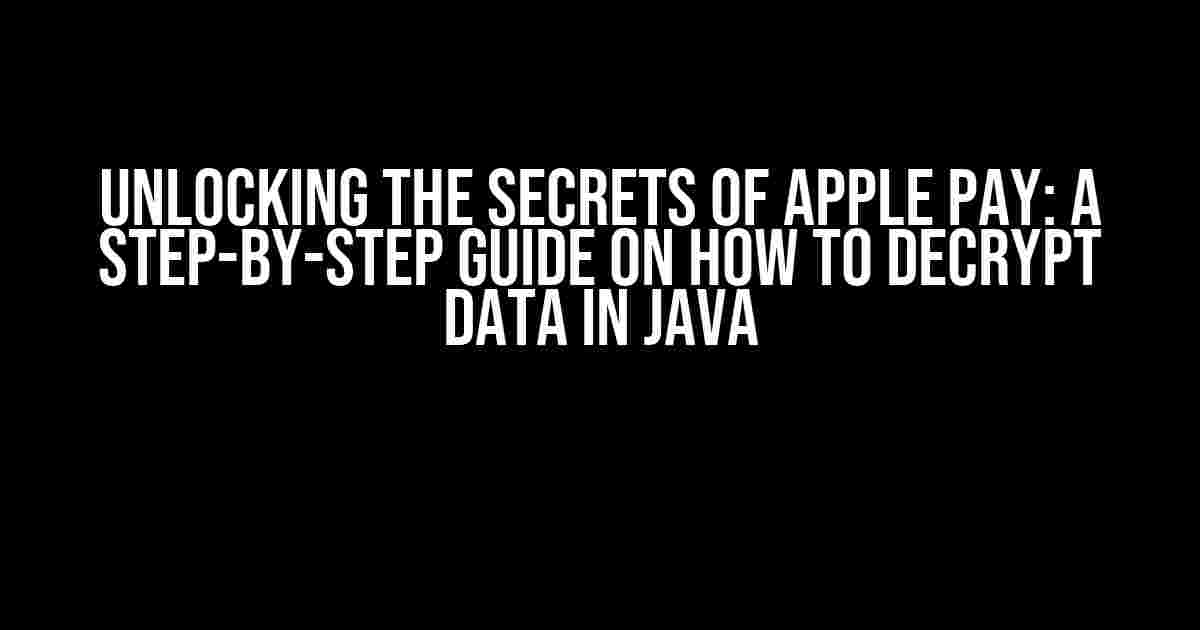Are you tired of feeling like a mysterious cryptographer trying to decipher the secrets of Apple Pay? Worry no more! In this comprehensive guide, we’ll demystify the process of decrypting data in Apple Pay using Java. Buckle up, folks, and let’s dive into the world of cryptography!
Understanding Apple Pay and its Encryption
Apple Pay is a mobile payment and digital wallet service that allows users to make payments online and in-store using their iOS devices. To ensure the security of transactions, Apple Pay uses a combination of encryption techniques to protect sensitive data, such as credit card numbers and expiration dates.
When a user adds a credit card to Apple Pay, the card information is encrypted and stored securely on the device. This encrypted data is then transmitted to the merchant’s payment processor during a transaction. To decrypt this data, developers need to use the Apple Pay Payment Token, which is a JSON Web Token (JWT) that contains the encrypted payment information.
Decrypting Apple Pay Data in Java
Now that we’ve covered the basics of Apple Pay encryption, let’s get our hands dirty and explore how to decrypt the data in Java!
Prerequisites
Before we begin, make sure you have the following:
- Java 8 or higher installed on your machine
- A basic understanding of Java and cryptography concepts
- The Apple Pay Payment Token (we’ll cover how to obtain this later)
- A Java-based project set up in your preferred IDE
Step 1: Adding Dependencies
In your Java project, add the following dependencies to your `pom.xml` file (if you’re using Maven) or your `build.gradle` file (if you’re using Gradle):
<dependency> <groupId>com.google.guava</groupId> <artifactId>guava</artifactId> <version>28.2-jre</version> </dependency> <dependency> <groupId>com.fasterxml.jackson.core</groupId> <artifactId>jackson-databind</artifactId> <version>2.12.3</version> </dependency> <dependency> <groupId>org.bouncycastle</groupId> <artifactId>bcprov-jdk15on</artifactId> <version>1.64</version> </dependency>
These dependencies will provide us with the necessary libraries for JSON parsing, cryptography, and certificate management.
Step 2: Obtaining the Apple Pay Payment Token
To decrypt the Apple Pay data, we need to obtain the Payment Token, which is a JWT that contains the encrypted payment information. You can obtain this token by integrating Apple Pay into your app and following the instructions provided by Apple.
For the purpose of this guide, let’s assume you’ve already obtained the Payment Token and have it stored in a string variable called `paymentToken`.
Step 3: Decrypting the Payment Token
Now it’s time to decrypt the Payment Token using the `ApplePayDecrypter` class. Create a new Java class with the following code:
import com.fasterxml.jackson.databind.JsonNode;
import com.fasterxml.jackson.databind.ObjectMapper;
import org.bouncycastle.jce.provider.BouncyCastleProvider;
import java.security.KeyFactory;
import java.security.PrivateKey;
import java.security.spec.PKCS8EncodedKeySpec;
public class ApplePayDecrypter {
private static final String ALGORITHM = "RSA";
private static final String PROVIDER = "BC";
public static JsonNode decryptPaymentToken(String paymentToken, String privateKey) throws Exception {
// Initialize the Bouncy Castle provider
Security.addProvider(new BouncyCastleProvider());
// Load the private key from a file or a string
KeyFactory keyFactory = KeyFactory.getInstance(ALGORITHM, PROVIDER);
PrivateKey privateKeyObject = keyFactory.generatePrivate(new PKCS8EncodedKeySpec(privateKey.getBytes()));
// Parse the Payment Token JSON
ObjectMapper mapper = new ObjectMapper();
JsonNode paymentTokenJson = mapper.readTree(paymentToken);
// Extract the encrypted payment data
String encryptedData = paymentTokenJson.get("paymentData").asText();
// Decrypt the payment data using the private key
Cipher cipher = Cipher.getInstance("RSA/NONE/OAEPwithSHA-256andMGF1padding", PROVIDER);
cipher.init(Cipher.DECRYPT_MODE, privateKeyObject);
byte[] decryptedData = cipher.doFinal(Base64.getDecoder().decode(encryptedData));
// Parse the decrypted payment data
JsonNode decryptedJson = mapper.readTree(decryptedData);
return decryptedJson;
}
}
This class uses the Bouncy Castle provider to decrypt the Payment Token using the private key. The `decryptPaymentToken` method takes the Payment Token and the private key as input and returns the decrypted payment data as a JSON node.
Step 4: Using the Decrypted Data
Now that we’ve decrypted the Payment Token, we can use the decrypted data to complete the payment processing. You can access the decrypted data using the `JsonNode` object returned by the `decryptPaymentToken` method.
For example, to access the credit card number, you can use the following code:
JsonNode decryptedJson = ApplePayDecrypter.decryptPaymentToken(paymentToken, privateKey);
String creditCardNumber = decryptedJson.get("paymentMethod").get("cardNumber").asText();
Congratulations! You’ve successfully decrypted the Apple Pay data in Java.
| Decrypted Data | Description |
|---|---|
| paymentMethod.cardNumber | Credit card number |
| paymentMethod.expirationMonth | Expiration month of the credit card |
| paymentMethod.expirationYear | Expiration year of the credit card |
| paymentMethod.cardholderName | Cardholder name |
Conclusion
In this comprehensive guide, we’ve explored the world of Apple Pay encryption and decryption using Java. By following these steps, you can securely decrypt the Apple Pay data and access the sensitive information needed for payment processing.
Remember to always handle sensitive data with care and follow the best practices for security and encryption. Happy coding!
Stay tuned for more exciting guides and tutorials on cryptography and Java development!
Frequently Asked Question
Get ready to unlock the secrets of decrypting data in Apple Pay using Java!
Q1: What is the first step to decrypt Apple Pay data in Java?
Ah-ha! The first step is to fetch the encrypted payment data from the Apple Pay payment token. You can achieve this by using the `retrievePayment Method` of the `PKPayment` API.
Q2: How do I extract the encryption certificate from the Apple Pay payment token?
Great question! You can extract the encryption certificate by parsing the `paymentData` property of the `PKPayment` object. The certification is embedded in the `paymentData` as a Base64-encoded DER-encoded X.509 certificate.
Q3: What encryption algorithm does Apple Pay use to encrypt the payment data?
Apple Pay employs the Elliptic Curve Integrated Encryption Scheme (ECIES) to encrypt the payment data. This ensures secure data transmission and protection.
Q4: Can I use a Java library to decrypt the Apple Pay payment data?
Yes, you can! There are several Java libraries available that can help you decrypt the Apple Pay payment data, such as Java Cryptography Extension (JCE) or the Apple-provided Java SDK for Apple Pay.
Q5: Are there any security considerations I should keep in mind when decrypting Apple Pay data in Java?
Absolutely! When handling sensitive payment data, ensure you follow best practices for secure coding and data storage. Always use secure protocols, such as HTTPS, and adhere to Apple’s guidelines for handling Apple Pay data.


